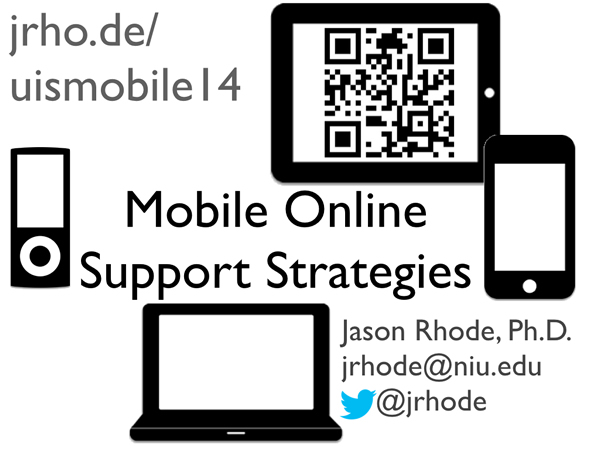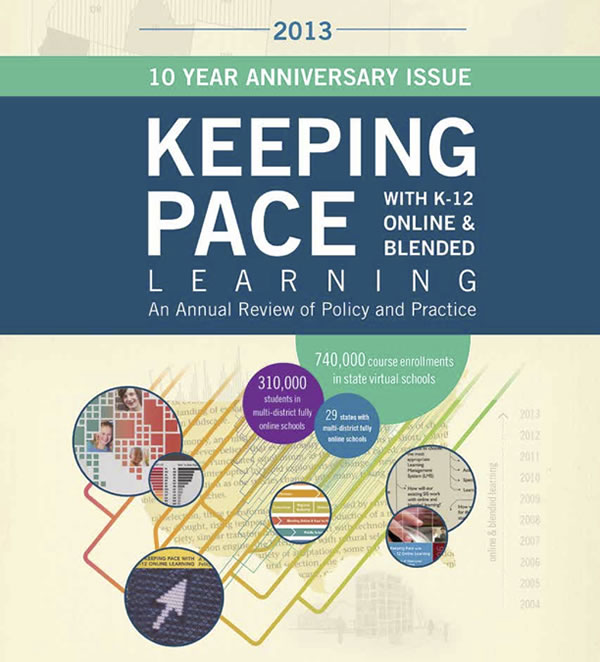
I was honored to be invited to give a keynote presentation for the Symposium for Online Program Coordinators at the University of Illinois at Springfield (UIS) on February 21, 2014 on the topic of mobile support tools and tips for supporting online students. My 90-minute talk titled Mobile Online Support Strategies for Serving Today’s Connected Online Students was an interactive, hands-on session where online program coordinators at UIS used their iPads to access resources, try different mobile communication tools, and brainstorm ideas. Together participants experienced a wide variety of mobile apps and services that they can choose from in crafting their own mobile communication strategy to better reach the online learners they serve. I prepared a mobile friendly online handout at jrho.de/uismobile14 to accompany the talk where session slides and resources can be found.
Mobile Online Support Strategies for Serving Today’s Connected Online Students
Best Practices in Online Teaching
Online teaching presents a unique set of challenges that require clear definition of faculty performance. Research shows that specific strategies can support and enhance the teaching and learning process. In this online workshop offered 2/14/14 for NIU faculty, we examined and discussed best practices that will promote successful online experiences including planning and management, teaching techniques, and assessing and evaluating students. Participants discovered different ways to facilitate these strategies during all phases of an online course. Special thanks to Angela Velez-Solic and Jeff Geronimo for their ideas and contributions to the workshop! The workshop archive may be viewed below.
The following is a quick list of the tips discussed in greater depth during the workshop archive.
If You’re New to Online Teaching
- Try using different kinds of online technologies in your current face-to-face or blended courses first, so you can get a good idea of how you might later use the technology to teach completely online.
- If you haven’t taught the course face-to-face, try teaching it that way first so you can fully understand the course components and student needs. Along the way, you’ll see what works and what doesn’t, and you might be able to have a solid idea of how to approach the same class in a fully online environment.
- Discuss and network with colleagues who have experience teaching online. They will be more than likely be willing to share with you some of their own tips and best practices, especially if these colleagues teach in your same subject area.
Tips for Design
- Rethink your syllabus. Create a loop-hole free syllabus and consider creating a syllabus quiz to make sure students know exactly what is expected of them.
- Organize your course content. You might decide to structure your course in weekly folders or by topic or theme.
- Avoid useless clicking. Put as much content in one place as possible, but also be mindful of how everything is structured so that you and your students avoid any unnecessary clicking.
- Save files in PDF. Converting your documents to PDF makes them more accessible to students, and is much smaller in terms of file size. When converting to PDF, remember to keep the source files in a safe place.
- Create a Start Here area to orient your learners to your course. This would be a good place to put information about navigating the online course and any resources for tech support
- Design less and teach more. It’s definitely NOT a good idea to try to design, develop, and teach a course at the same time. (tell short story) Ultimately, try to make sure the course is as fully developed as possible before the start of the semester, so that you can focus on the more important aspect – teaching the course.
- Rethink your course content. Just because you’re teaching a course online, you don’t need to create all course materials from scratch. Consider using open educational resources like YouTube videos, TED talks, and more.
- Embed media within your course whenever possible instead of linking. From a learner’s perspective, it’s just easier to be able to see and view the content within the course without having to click on multiple links to open in new windows.
Tips for Delivery
- Plan your delivery. Use announcements weekly and save them in a file for easy access especially if you teach the same course multiple times. Save “general” discussion responses in a document, so you don’t have to repeat yourself all the time.
- Run from the email monster. Being tied to email or feeling compelled to answer emails is a very real nightmare for many online faculty. Instead, try the following: hold virtual office hours using Adobe Connect or Blackboard Collaborate; subscribe to discussion forums/threads; create announcements in advance and post-date them; try Remind101 or Google Voice for text messages
- Rethink email. set a realistic time schedule; set up email access on your mobile device; encourage other avenues of communication
- Move beyond PowerPoint. Consider alternatives to PowerPoint slides. You can add audio narration to PowerPoint, record face-to-face lectures for later viewing, or perhaps record a screencast.
- Consider live online sessions. You do certainly have the option use live online sessions for delivering content and facilitate live online discussions. In your online course, you could choose to have live online sessions scheduled periodically throughout your course in which you could require students to login at the scheduled time from either their computer or mobile device to participate in a live class meeting where you could present content as well as facilitate a variety of different types of discussions.
- Develop your “presence”. Consider other ways where you can demonstrate your teaching and social presence in the course, such as recording video or making other frequent communications within the course.
Tips for Assessment
- Rethink your grading strategies. Use grading criteria and rubrics for all assignments and discussions; incorporate more low-stakes quizzes with multiple attempts; provide feedback, and allow students to revise assignments; try project-based learning – all assignments are part of the final project.
- Consider different grading methods. Download all submissions at once from LMS and annotate with MS Word; use inline grading feature in Blackboard; convert assignments to PDF and annotate (options for grading from mobile device); use rubrics or audio/video feedback
- Give and receive feedback. Save samples of phrases and feedback and copy/paste as appropriate to save time; provide informal opportunities for course feedback; use LMS survey tool, PollEverywhere, reflection journals; ask for feedback mid-point and end of course.
Summary and Best Practices
- Take baby steps. Don’t plunge so deeply into the online course environment and expect everything to be perfect.
- Limit the amount of technology if you’re brand new. The technology should not drive or direct the teaching and learning process – it should support this process.
- Explore different strategies and approaches. See what works for you and your teaching style.
- Don’t overwhelm yourself of your students. Make sure the course is as easy to navigate as possible, provide clear expectations, and make sure that the overall design of the course makes for a positive course experience for everyone.
For archives of other online workshops offered by NIU Faculty Development and Instructional Design Center, visit our YouTube channel. Those seeking to design a new online course in Blackboard may find the workshop archive, Designing Exemplary Online Courses in Blackboard, to be of particular help.
What’s New with SARA? Update on the National State Authorization Reciprocity Agreement
The national initiative, the State Authorization Reciprocity Agreement (SARA) will create interstate reciprocity in the regulation of postsecondary distance education. The four regional higher education compacts – the Midwestern Higher Education Compact, New England Board of Higher Education, Southern Regional Education Board, and Western Interstate Commission for Higher Education, will collaborate to make distance education courses more accessible to students across state lines, as well as making it easier for states to regulate and institutions to participate in interstate distance education.
During this 75 minute recorded webcast from 1/23/14, Marshall Hill, executive director of the National Council for State Authorization Reciprocity Agreements (NC-SARA); Rhonda Epper, director of WICHE SARA; and Russell Poulin, deputy director for research and analysis at WCET.
The webcast covered:
- Key facts about SARA
- How your state and institution can participate
- The projected timeline for implementation
Resources
2013 Survey of Online Learning Report

“Grade Change: Tracking Online Education in the United States, 2013”
 This is the 11th annual report on the state of online learning in U.S. higher education from the Babson Survey Research Group, Pearson and the Sloan Consortium:
This is the 11th annual report on the state of online learning in U.S. higher education from the Babson Survey Research Group, Pearson and the Sloan Consortium:
- Is Online Learning Strategic?
- Are Learning Outcomes in Online Comparable to Face-to-Face Learning?
- How Many Students are Learning Online?
- How are Massive Open Online Courses (MOOCs) faring?
- And much more…
This survey also reveals that in 2013:
- 7.1 million higher education students are taking at least one online course.
- The 6.1 % growth rate represents over 400,000 additional students taking at least one online course.
- The percent of academic leaders rating the learning outcomes in online education as the same or superior to those as in face-to-face instruction, grew from 57% in 2003 to 74% in 2013.
- The number of students taking at least one online course continued to grow at a rate far in excess of overall enrollments, but the rate was the lowest in a decade.
This video gives some quick stats and insight into findings from the study.
Keeping Pace with K-12 Online Learning: An Annual Review of Policy and Practice (2013)

Keeping Pace with K-12 Online Learning: An Annual Review of Policy and Practice (2013) is the 10th in a series of annual reports that began in 2004 that examine the status of K-12 online education across the country. The report provides an overview of the latest policies, practices, and trends affecting online learning programs across all 50 states.
Keeping Pace is researched and published as a service to the educational and governmental communities. Distribution of the report and graphics for presentations are free.
Download the full 2013 report
Download the Planning for Quality Booklet

